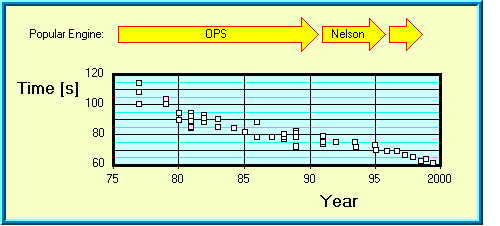History of Lap Times |
R/C pylon racing became feasible in the 1960s, when the R/C equipment was improved and finally lead to systems with simultaneous proportional transmission. The first contests were organized in the USA in the early 1960s. In the beginning, a distance of 1/10 mile between two pylons was used, which had to be circled 5 times, resulting in 1 mile flown. Because only one pilot flew against the clock, it was not comparable to the modern pylon racing atmosphere, where, at the same time, 3 or 4 pilots compete against each other. During these days, people like Jerry Nelson, Hal deBolt, and Howard Bonner contributed much to the development of R/C pylon racing.
The first pylon racing event in Germany took place in 1969, initiated by the well known Manfred Pick, who is still in the business today. Together with his team mate Lothar Steinbiß, he was found in the top ranks of most major European events throughout several decades - and even today, he is very successful in the circus.
The following graph shows the development of typical times of the European (in fact mainly German) top pilots versus time.

History of time per lap of European top aces (selected from contest
results).
It should be noted, that some of the variations are due to changes in the FAI or the national contest rules, but in general, the improvements are the results of model and engine optimizations. During the first half of the 1980s the aerodynamics of models and propellers has been examined carefully, which led to new airfoils and model geometries. During the 1990s the manufacturing quality of the models was greatly improved through the use of CNC machined moulds and there seems to be still some movement in the engine area. In 1996 the 70 second barrier has been broken regularly. The standards have been set quite high already, which is indicated by the smaller advances during the last years. Today, times in the order of 60 to 65 seconds are flown by the top pilots.
Most of the information given in the next sections are based on work, that was carried out in the early 1980s by members of the Akamodell Stuttgart, Germany. That is why some of the engine and model data are a bit outdated, but the principles shown are still applicable.
Last modification of this page: 21.05.18
![]()
[Back to Home Page] Suggestions? Corrections? Remarks? e-mail: Martin Hepperle.
Due to the increasing amount of SPAM mail, I have to change this e-Mail address regularly. You will always find the latest version in the footer of all my pages.
It might take some time until you receive an answer
and in some cases you may even receive no answer at all. I apologize for this, but
my spare time is limited. If you have not lost patience, you might want to send
me a copy of your e-mail after a month or so.
This is a privately owned, non-profit page of purely educational purpose.
Any statements may be incorrect and unsuitable for practical usage. I cannot take
any responsibility for actions you perform based on data, assumptions, calculations
etc. taken from this web page.
© 1996-2018 Martin Hepperle
You may use the data given in this document for your personal use. If you use this
document for a publication, you have to cite the source. A publication of a recompilation
of the given material is not allowed, if the resulting product is sold for more
than the production costs.
This document may accidentally refer to trade names and trademarks, which are owned by national or international companies, but which are unknown by me. Their rights are fully recognized and these companies are kindly asked to inform me if they do not wish their names to be used at all or to be used in a different way.
This document is part of a frame set and can be found by navigating from the entry point at the Web site http://www.MH-AeroTools.de/.